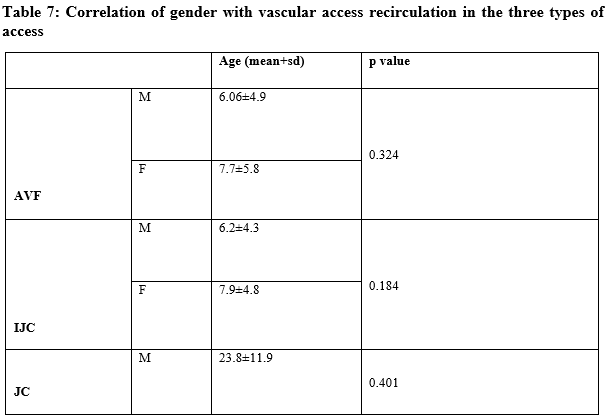Access recirculation and adequacy of hemodialysis in different types of vascular access
Abstract
Introduction: Haemodialysis requires recirculation, and it happens when dialysed blood returning through the venous needle re-enters the extracorporeal circuit through the arterial needle, rather than returning to the systemic circulation. Significant recirculation should be expected, when there is an inadequate reduction in the values of urea. During End-Stage Renal Disease (ESRD), adequate dialysis is of utmost importance because it influences the morbidity and mortality of the patients. Methods and materials: The study was carried out in 200 patients who underwent haemodialysis at the dialysis unit in Kalyani kidney care centre, Erode. Patients were actively evaluated from February 2018 till November 2018. Patients were randomized and accordingly 64 patients were enrolled in category I Arteriovenous fistula (AVF), 63 Patients in category II Internal Jugular Catheter (IJC) and category III Femoral Catheter (FC) each and 10 patients in category IV Perm Catheter (PC). Success recirculation was estimated and adequacy of haemodialysis was done virtually. Calculated Kt/V was done in almost all patients. For assessing vascular access recirculation, the technique that was used was urea-based measurement (Two needles with three samples of blood). The recirculation percentage was calculated as(S-A)/(S-V) X100. For assessing the adequacy of haemodialysis, Kt/V was used where K is estimated from (Cbi-Cbo)/ (CbixQb), time duration of dialysis (t) and urea distribution volume (V) is determined from the Watson equations for men and women. Kt/V was also measured with Online Clearance Monitoring (OCM) in Fresenius machine 4000S. Results: The mean access recirculation rate was 6.3+5.1% in those with AVF, while in IJC and FC groups were 6.7+4.5% and 24.4+11.7% respectively. When the two groups were compared, AVF vs FC groups, the difference was statistically significant (p value<0.001) and in IJC vs FC groups, the difference was statistically less significant (p-value <0.001) in both AR% and online Kt/V. Conclusion: An arteriovenous2QQ2 fistula has less access recirculation, when compared to temporary catheters. On the other hand, the femoral catheter has more access recirculation, when compared to the internal jugular catheter. The difference in calculated Kt/V with the three types of vascular access has no statistical significance.
Downloads
References
Shayanpour S, Faramarzi M. Arteriovenous Fistula Recirculation in Hemodialysis. Nephrourol Mon. 2015 Jul 22;7(4):e27474. doi: 10.5812/numonthly.27474.
Mousavi SB, Tavazoe M, Hayati F, Sametzadeh M. Arterio-Venous fistula recirculation in hemodialysis: causes and prevalences. Shiraz E Med J. 2010;11(4):219–24. http://semj.sums.ac.ir/vol11/oct2010/88055.htm.
Sherman RA, Matera JJ, Novik L, Cody RP. Recirculation reassessed: the impact of blood flow rate and the low-flow method reevaluated. Am J Kidney Dis. 1994 Jun;23(6):846-8. doi: 10.1016/s0272-6386(12)80138-7.
Schneditz D. Recirculation, a seemingly simple concept. Nephrol Dial Transplant. 1998 Sep;13(9):2191-3. doi: 10.1093/ndt/13.9.2191.
Zeraati A, Beladi Mousavi SS, Beladi Mousavi M. A review article: access recirculation among end stage renal disease patients undergoing maintenance hemodialysis. Nephrourol Mon. 2013 Spring;5(2):728-32. doi: 10.5812/numonthly.6689. Epub 2013 Mar 30.
Inoue KC, Kuroda CN, Nakayama KG, Dell'Agnolo CM, Matsuda LM. Comparison between two methods for evaluation of the dialysis dose quality. Acta Paul Enferm. 2009;22(special issue 1):494-6. DOI: 10.1590/S0103-21002009000800007
Salimi J, Razeghi E, Karjalian H, Meysamie A, Dahhaz M, Dadmehr M. Predicting hemodialysis access failure with the measurement of dialysis access recirculation. Saudi J Kidney Dis Transpl. 2008 Sep;19(5):781-4.
Besarab A, Sherman R. The relationship of recirculation to access blood flow. Am J Kidney Dis. 1997 Feb;29(2):223-9. doi: 10.1016/s0272-6386(97)90033-0.
Bay WH, Henry ML, Lazarus JM, Lew NL, Ling J, Lowrie EG. Predicting hemodialysis access failure with color flow Doppler ultrasound. Am J Nephrol. 1998;18(4):296-304. doi: 10.1159/000013354.
Al Saran K, Sabry A, Abdulghafour M, Yehia A. Online conductivity monitoring of dialysis adequacy versus Kt/V derived from urea reduction ratio: a prospective study from a Saudi Center. Ren Fail. 2010 Jan;32(1):36-40. doi: 10.3109/08860220903367486.
Watson PE, Watson ID, Batt RD. Total body water volumes for adult males and females estimated from simple anthropometric measurements. Am J Clin Nutr. 1980 Jan;33(1):27-39. doi: 10.1093/ajcn/33.1.27.
Little MA, Conlon PJ, Walshe JJ. Access recirculation in temporary hemodialysis catheters as measured by the saline dilution technique. Am J Kidney Dis. 2000 Dec;36(6):1135-9. doi: 10.1053/ajkd.2000.19821.

Copyright (c) 2021 Author (s). Published by Siddharth Health Research and Social Welfare Society

This work is licensed under a Creative Commons Attribution 4.0 International License.


 OAI - Open Archives Initiative
OAI - Open Archives Initiative


